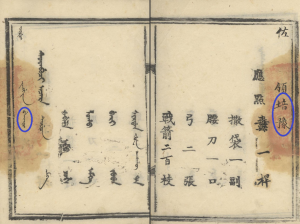【注意:原文题为《不要使用锡伯音节边界标记》。但是经过这么长时间,我的观点已经发生了变化。题目更改为《关于锡伯音节边界标记》,进而更改为《关于蒙古隔音符号》。】
 Unicode U+1807定义为蒙古标点符号,命名为“Mongolian Sibe Syllable Boundary Marker”(MSSBM),直译即“蒙古锡伯音节边界标记”。这个符号的显形与字母 a 的词中型,也就是字牙,完全相同。
Unicode U+1807定义为蒙古标点符号,命名为“Mongolian Sibe Syllable Boundary Marker”(MSSBM),直译即“蒙古锡伯音节边界标记”。这个符号的显形与字母 a 的词中型,也就是字牙,完全相同。
The Unicode Standard, Version 5.0
Syllable Boundary Marker. U+1807 MONGOLIAN SIBE SYLLABLE BOUNDARY MARKER, which is derived from the medial form of the letter a (U+1820), is used to disambiguate syllable boundaries within a word. It is mainly used for writing Sibe, but may also occur in Manchu texts. In native Manchu or Sibe words, syllable boundaries are never ambiguous; when transcribing Chinese proper names in the Manchu or Sibe script, however, the syllable boundary may be ambiguous. In such cases, U+1807 may be inserted into the character sequence at the syllable boundary.
翻译成中文:
统一码标准,版本5.0
音节边界标记。U+1807蒙古锡伯音节边界标记,来源于字母a(U+1820)的词中型,用于解决词内音节的界限发生混淆的情况。该符号主要用于锡伯文,但也用于满文。在满文和锡伯文的固有词汇中,音节的界限根本没有发生混淆的情况;然而在音译汉语的专有名词时,音节的界限就有可能发生混淆。在这种情况下,U+1807就可以插入到字符顺序的音节边界。
最初,我对MSSBM有很多疑问。
1. 这个符号在其他任何书中都没有提到过。
2. 这个符号外形完全等同于a的词中型,即字牙。
3. 这是个符号,不是字母。
4. 如何区分这个符号和字母a?
5. 这个符号可以用在任何元音字母后或任何元音字母前吗?
6. 这个符号可以用在辅音字母后或辅音字母前吗?
我问了Sure这个符号的问题。他给了我几个清朝的书中的几个例子。我也找到了蒙古文中的例子。
《點名簿》的两页:
图中pei~中的i为不规范写法。
以耆英 (Qíyīng)的满文为例。有三种解释:
1. ki|ing:ki和ing之间的字牙是MSSBM。
2. kii^ng:第二个i后面是FVS1,以得到一个字牙加一个长牙的外形。
3. kiing:第二个i自动变成了一个字牙加一个长牙的外形。(假设i后面的i就应该这么写。)
《统一码标准》选择了第一种解释。我曾经选择第二种。有些人会选择第三种。
稍等一下,我们看一下蒙古文的“第二词根”问题。 如果一个音节以元音字母开始,同时这个音节又不是单词中的第一个音节,我们要在这个音节的这个元音字母前多写一个字牙。这个音节前的音节可以以元音字母结尾,也可以以辅音字母结尾。
老蒙文中的有些固有词汇也包含这种情况。
 请看右边的老蒙文单词。绿色的字牙是字母n,蓝色的字肚是o。中间的红色的字牙就是用于区分前后两个音节的。
请看右边的老蒙文单词。绿色的字牙是字母n,蓝色的字肚是o。中间的红色的字牙就是用于区分前后两个音节的。红色的字牙和蓝色的字肚共同组成了字母o。红色的字牙并不是MSSBM。
据说所有元音字母前都可以这样用,但是a和e可能另有用法。
如果我们需要这个符号,我们不应该称之为“蒙古锡伯音节边界标记”,而应该称之为“蒙古音节边界标记”,进一步翻译为“蒙古隔音符号”。不过,很多人会说,老蒙文没有蒙古音节边界标记啊!
既然老蒙文和满文、锡伯文使用同一文字系统,我们不能把同一情况区别对待。 那么我们就应该使用传统方法:
如果一个音节以元音字母开始,同时这个音节又不是单词中的第一个音节,我们要在这个音节的这个元音字母前多写一个字牙。
输入单词时,在这个音节的元音字母后输入FVS1。
太清转写中,建议使用x^这种方法。但是,|x也是可接受的方式。这里,x代表任一元音字母。|x是与MSSBM的一种兼容方法。
下面是所有老蒙文、满文、锡伯文中含一个额外字牙的元音字母形式。 以后会继续说明a和e的情况。以后继续讨论这个问题。
About "Mongolian Sibe Syllable Boundary Marker"
Unicode U+1807 is defined as a Mongolian punctuation and named "Mongolian Sibe Syllable Boundary Marker" (MSSBM). The marker represents as the grapheme of the middle form of letter A.
The Unicode Standard, Version 5.0
Syllable Boundary Marker. U+1807 MONGOLIAN SIBE SYLLABLE BOUNDARY MARKER, which is derived from the medial form of the letter a (U+1820), is used to disambiguate syllable boundaries within a word. It is mainly used for writing Sibe, but may also occur in Manchu texts. In native Manchu or Sibe words, syllable boundaries are never ambiguous; when transcribing Chinese proper names in the Manchu or Sibe script, however, the syllable boundary may be ambiguous. In such cases, U+1807 may be inserted into the character sequence at the syllable boundary.
At first, I’m curious about SSBM.
1. The mark is not mentioned in any book.
2. It looks the same as the medial form of the letter a.
3. It is a mark, not a letter.
4. How to distinguish SSBM from the letter a?
5. Can it be used after or before all of the vowel letters?
6. Can it be used after or before a consonant letter?
I have discussed this with Sure. He gave me a few example from books published in Qing dynasty. I found some examples in Traditional Mongolian.
Two pages in 《點名簿》 (Dian Ming Bu):
Here i in pei is an informal form.
Take the name 耆英 (Qíyīng) as an example. There are three explanations:
1. ki|ing: The tooth (字牙) between ki and ing is SSBM.
2. kii^ng: The second i is followed by FVS1 to get the form of a tooth and long tooth (长牙).
3. kiing: The second i is transformed to the form of a tooth and long tooth automatically. (Suppose this is the default form for i after i.)
The Unicode Standard chose Option 1. I choose option 2. Some people will choose Option 3.
Wait a moment. Let’s refer to Traditional Mongolian – the double radical issue.
If a syllable is beginning with a vowel letter and the syllable is not the first syllable in a word, we need to put an additional tooth before the vowel letter of the syllable. The syllable in the front can end with a vowel or consonant letter.
A few intrinsic words in Mongolian have this kind of syllables.
See the Mongolian word in the right. The green tooth is n and the blue belly (字腹) is o. The red tooth is the one to separate the syllables. The red tooth and the blue belly together form o. It is not SSBM.
It’s said that the rule can be used before all vowel letters but a and e probably will follow another rule.
If we need such a mark, we can't name it as Mongolian Sibe Syllable Boundary Marker – we should name it as Mongolian Syllable Boundary Marker. But people will say that there is no Mongolian Syllable Boundary Marker in Mongolian.
We can't treat Mongolian and Sibe in different ways because they share the same writing system.
Then we should use the traditional way:
If a syllable is beginning with a vowel letter and the syllable is not the first syllable in a word, we need to put an additional tooth before the vowel letter of the syllable.
Put FVS1 after the vowel letter when input the word.
In Abkai Translileration, x^ is recommended. But |x is also accepted. Here x is any of the vowels. |x is compatible with SSBM.
All the written forms of the vowels of Traditional Mongolian, Manchu and Sibe with the additional tooth.
Read my later post about a and e in this situation.I will continue studying more on this.





e在这种情况下 就没有这个符号 而是直接一个 字牙 参见 hi^en
这个词哪里出现的?你说的应该写作下面的第4种情况?
改了一下。现在评论应该也能放图片了。
左1:hien,默认直接写。当然是不能这么写的。
左2:可能的hi|en,hi和en之间加入一个字牙。
左3:可能的hi|en,hi和en之间加入一个字牙,e只是字脊,并且不延长字脊。
左4:可能的hi|en,hi和en之间加入一个字牙,e只是字脊,并且延长字脊。
a单写的时候就是两个字牙,其中第一个就等于SSBM吧。e单写等于一个字牙加光的字脊,也是一样。所谓SSBM实际就是零声母的词中形,这一点连着维语ئ看就很清楚了。因此上面第四种hi^en是不错的。
对。实际上,这个符号是辅音字母,是零声母,称为符号字母可能更合适。在词首写作字冠,在词中写作字牙。
词首的字冠习惯被认为是元音字母的一部分,而词中的情况也不见于满文固有词,但是蒙文中,合成词的词中偶有该符号,但是一般也被认为是元音字母的一部分。
上面4个单词分别对应为 hien* hiaen* hian* hi@en【星号代表错误】,正确的写法是第4个。还可写作 hi@en^,就是 n 加个点。
新的太清满文字体能够按照上述描述正确处理该符号。